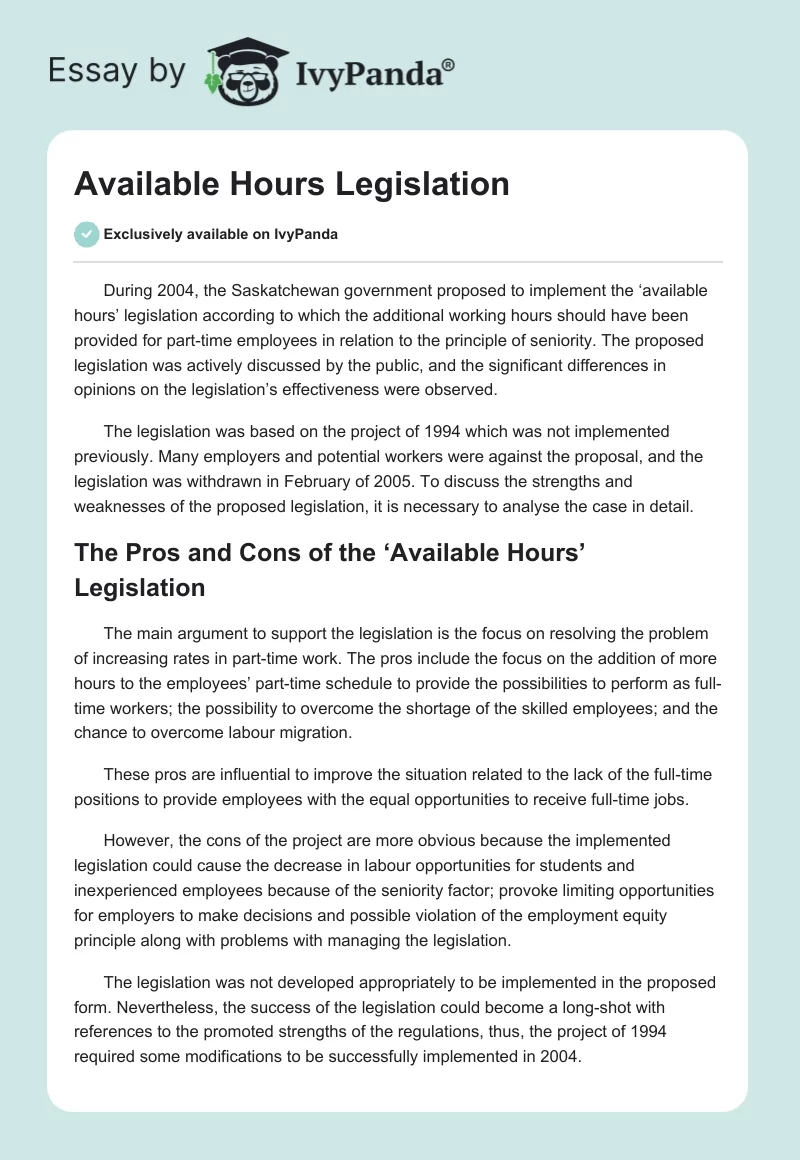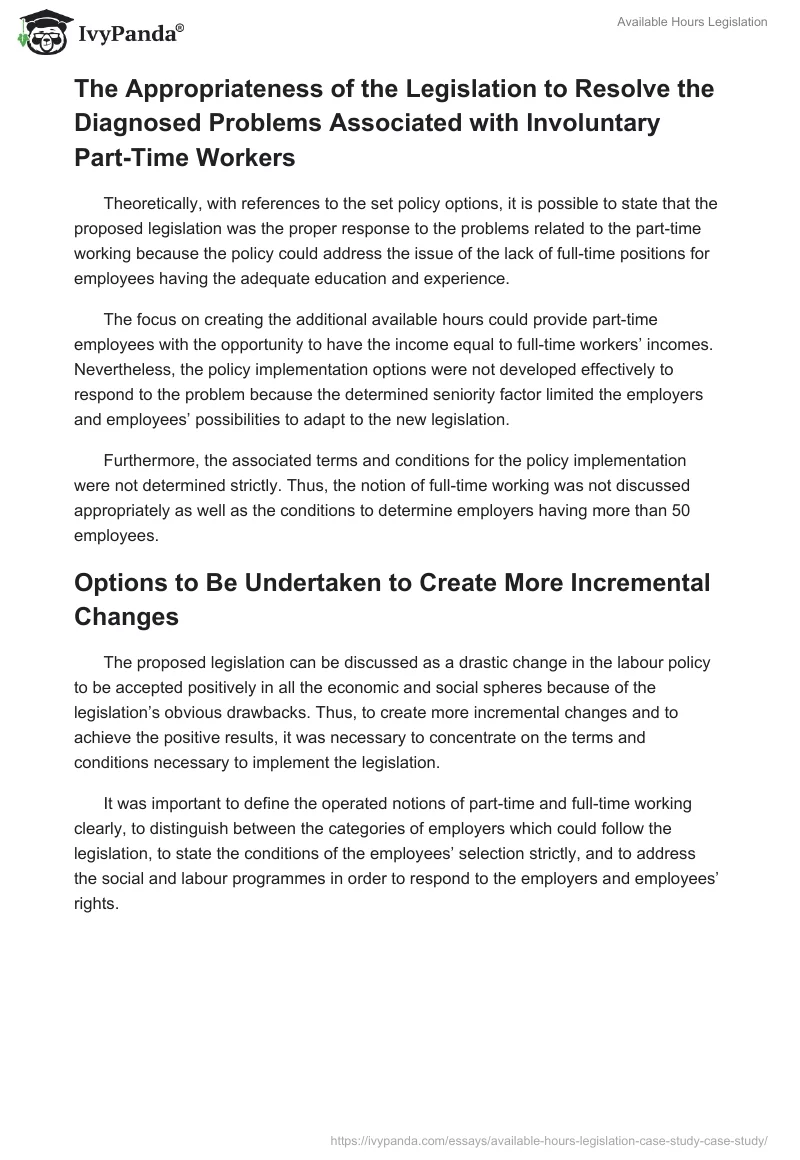Introduction
During 2004, the Saskatchewan government proposed to implement the ‘available hours’ legislation according to which the additional working hours should have been provided for part-time employees in relation to the principle of seniority. The proposed legislation was actively discussed by the public, and the significant differences in opinions on the legislation’s effectiveness were observed.
The legislation was based on the project of 1994 which was not implemented previously. Many employers and potential workers were against the proposal, and the legislation was withdrawn in February of 2005. To discuss the strengths and weaknesses of the proposed legislation, it is necessary to analyse the case in detail.
The Pros and Cons of the ‘Available Hours’ Legislation
The main argument to support the legislation is the focus on resolving the problem of increasing rates in part-time work. The pros include the focus on the addition of more hours to the employees’ part-time schedule to provide the possibilities to perform as full-time workers; the possibility to overcome the shortage of the skilled employees; and the chance to overcome labour migration.
These pros are influential to improve the situation related to the lack of the full-time positions to provide employees with the equal opportunities to receive full-time jobs.
However, the cons of the project are more obvious because the implemented legislation could cause the decrease in labour opportunities for students and inexperienced employees because of the seniority factor; provoke limiting opportunities for employers to make decisions and possible violation of the employment equity principle along with problems with managing the legislation.
The legislation was not developed appropriately to be implemented in the proposed form. Nevertheless, the success of the legislation could become a long-shot with references to the promoted strengths of the regulations, thus, the project of 1994 required some modifications to be successfully implemented in 2004.
The Appropriateness of the Legislation to Resolve the Problems Associated with Involuntary Part-Time Workers
Theoretically, with references to the set policy options, it is possible to state that the proposed legislation was the proper response to the problems related to the part-time working because the policy could address the issue of the lack of full-time positions for employees having the adequate education and experience.
The focus on creating the additional available hours could provide part-time employees with the opportunity to have the income equal to full-time workers’ incomes. Nevertheless, the policy implementation options were not developed effectively to respond to the problem because the determined seniority factor limited the employers and employees’ possibilities to adapt to the new legislation.
Furthermore, the associated terms and conditions for the policy implementation were not determined strictly. Thus, the notion of full-time working was not discussed appropriately as well as the conditions to determine employers having more than 50 employees.
Options to Be Undertaken to Create More Incremental Changes
The proposed legislation can be discussed as a drastic change in the labour policy to be accepted positively in all the economic and social spheres because of the legislation’s obvious drawbacks. Thus, to create more incremental changes and to achieve the positive results, it was necessary to concentrate on the terms and conditions necessary to implement the legislation.
It was important to define the operated notions of part-time and full-time working clearly, to distinguish between the categories of employers which could follow the legislation, to state the conditions of the employees’ selection strictly, and to address the social and labour programmes in order to respond to the employers and employees’ rights.
The Necessity to Add Amendments to the 1994 Regulations
The idea of the 1994 legislation was theoretically good and to suit the modern workplace situation, it could be reasonable to add amendments to the developed project of 1994 in order to present the modern version in 2004.
The problem was in the fact that the necessary amendments or improvements were not developed appropriately, thus, the legislation remained to be weak to respond to the public’s needs in practice. The 1994 regulations could be developed to specify the conditions for implementation, to determine the stakeholders involved in the process directly, and to determine the frames of the project according to its goal.
The Role of Ambiguity for Influencing the Public’s Opinion
It is possible to assume that less ambiguity in the ‘available hours’ regulations could affect the public’s opinion on the legislation positively because of opportunities to analyse all the potential variants of the legislation’s implementation and outcomes.
Focusing on the complete picture of the legislation’s implementation with references to the necessary conditions and terms, it is possible to predict the outcomes of the project and see the perspectives more clearly.
Many persons can support the regulations with references to the idea of their visible effectiveness for many categories of the province’s population if the outcomes and conditions are determined strictly, without the unnecessary ambiguity in the outcomes’ interpretation.
The Appropriateness of Reintroducing the Legislation
The reintroduction of the legislation after the 10-year hiatus could have been successful if the necessary improvements were added to the regulations. The breakdown of the legislation’s reintroduction depends on the fact that the government failed to analyse all the possible sides and effects of the ‘available hours’ legislation in the modern world.
The acrimonious nature of the debate could be reduced while responding to the needs of all the categories of part-time workers, including students and inexperienced employees; and with addressing the interests of employers because of intentions to choose workers for new positions due to education and competency factors.
The draft of the project should have been expanded to demonstrate the paths for different stakeholders with the focus on the potential benefits.
The Criteria to Assess the Policy Development
It is important to determine several criteria to assess the policy development which are the time frame for realising the legislation, the expected impact on stakeholders, the possible adverse impacts, the predicted costs, the administrative ease of implementation, the associated legal considerations, the role for the social development, and the conditions for the further modifications.
These criteria are important to be looked at because the set time frame is necessary for employers to plan their work, and the expected positive outcomes affect the whole realisation of the project and the steps in implementation. The project should be assessed with references to the correlation between the expected positive outcomes, potential costs, and difficulties in implementation.
The Problems Associated with Withdrawing the Legislation
The fact of withdrawing the legislation without the attempts to improve the ineffective regulations is associated with the problem of non-resolving the issue of part-time workers’ percentage in the province of Saskatchewan.
While developing the legislation to resolve the problem in the labour market, it is necessary to overcome the weak points and improve the regulations. However, while withdrawing the legislation, it is impossible to provide the immediate solution for the problematic question.
The Consultation Check List
The consultation related to the implementation of the ‘available hours’ legislation should be realised in accordance to the special check list which should include such points as the potential impact of the legislation on different groups of the unemployed population, the impact on the experienced and inexperienced or student employees, the effects on the employers’ hiring process and profits, the role for the improvement of the social situation in the province, the impact on decreasing the labour migration in the region, the impact on increasing the part-time workers’ income, the response to the employment equity programmes, the potential risks of the legislation’s implementation, the role for addressing the employers’ rights, and the expected differences in affecting various industries.
The Risks Associated with Getting the Consultation Process Wrong
If the consultation process is developed according to the wrong path, and the inappropriate form of the legislation is implemented, the possible risks include the increase in the unemployment rate, the decrease in opportunities for students to find part-time jobs, the decrease in job flexibility for part-time workers chosen to take the new available positions.
The employers can become dissatisfied with the new regulations and seek for the variants to avoid the provision of the ‘available hours’. Moreover, the principle of seniority limits not only employers but also employees to demonstrate their competency. Thus, the risk of selecting incompetent candidates for the new available positions increases.
The Appropriate Form of Consultation
The focus on the public’s opinion and on participation of the businesses and social activists in the discussion of the legislation revealed many drawbacks in the proposed regulations. However, the other appropriate form to realise the consultation process is the concentration on the experts’ opinion.
It is rational to create the expert committee to analyse the possible negative and positive outcomes of the legislation’s implementation for all the stakeholders with references to the statistical data and social investigations because the proposed regulations satisfied only the government. The public should be provided with the research’s results to discuss and accept the proposed legislation.
Recommendations for the Government
The government should change the legislation to emphasise its positive outcomes for the businesses and to implement the regulations appropriately.
It is necessary to state clearly the time frame for the project’s realisation, to determine the conditions for referring to the legislation when it is necessary. This option includes the focus on the conditions for discussing the full-time or part-time jobs and the employers’ required participation in the project.
It is significant to work out the plan of actions for all the involved stakeholders. Thus, the criterion of seniority for choosing the candidate for the new available position should be eliminated, the possibilities for students and women should be expanded, and the conditions for employers to refuse following the legislation should be stated clearly.
Steps for Carrying Out the Plan
The steps for carrying out the plan are:
- The organisation of the expert committee to analyse the field and predict the outcomes.
- The discussion of the 1994 regulations’ weaknesses and of the proposed modifications.
- The development of the plan to address the stakeholders’ interests.
- The development of solutions for previous weaknesses.
- The public discussion of the draft.
- The revision of the draft with references to the public’s opinion.
- The provision of the arguments to support the government’s vision of the legislation with references to the research.
- The final revision of the project.
- The implementation stage.


